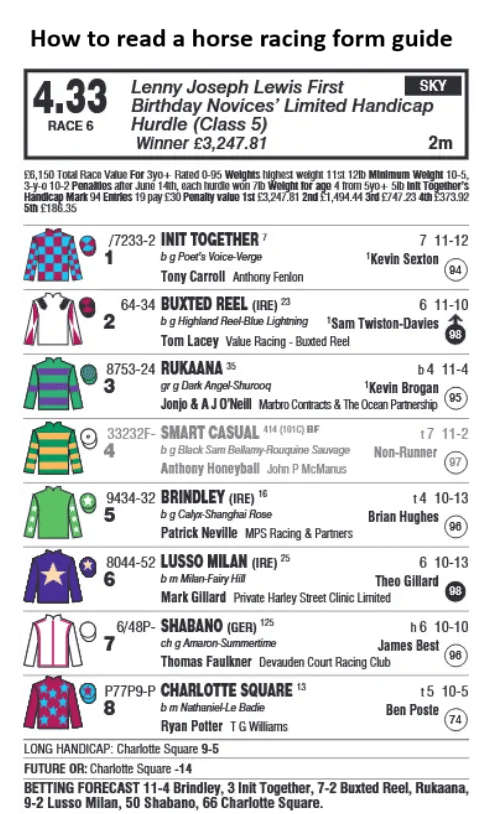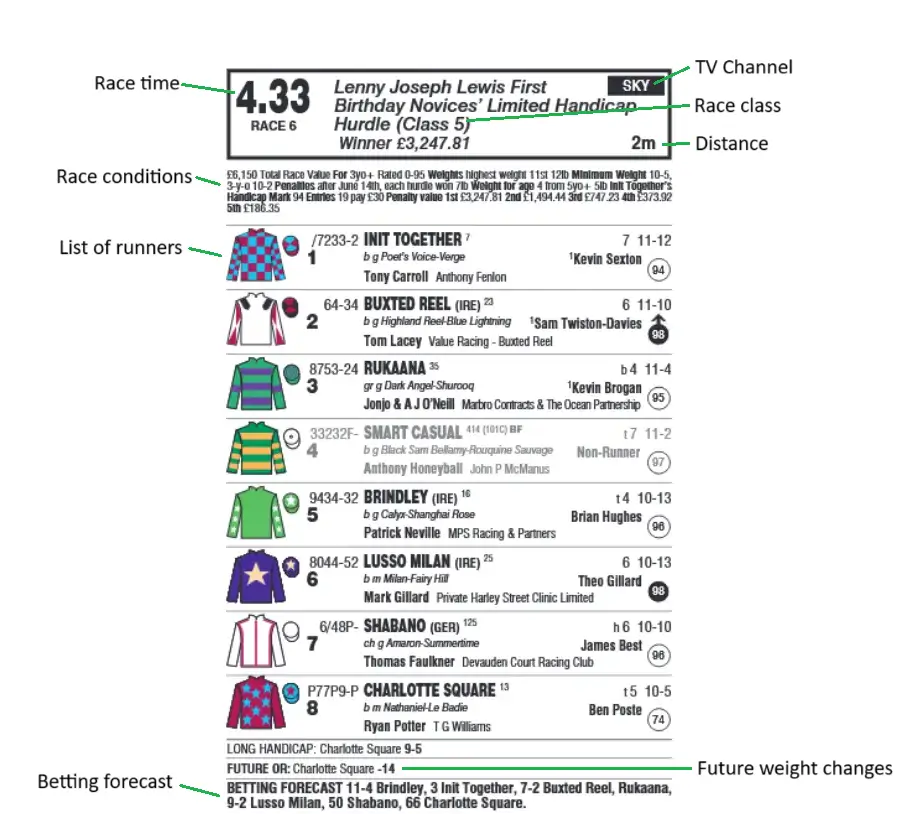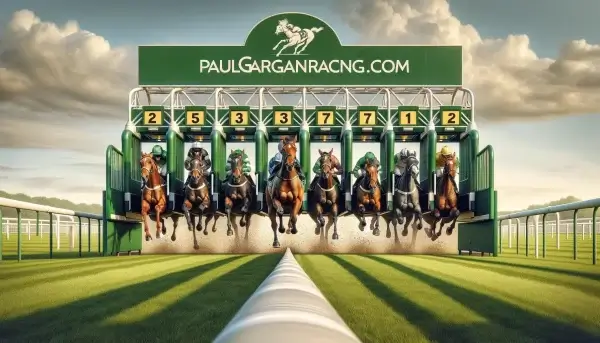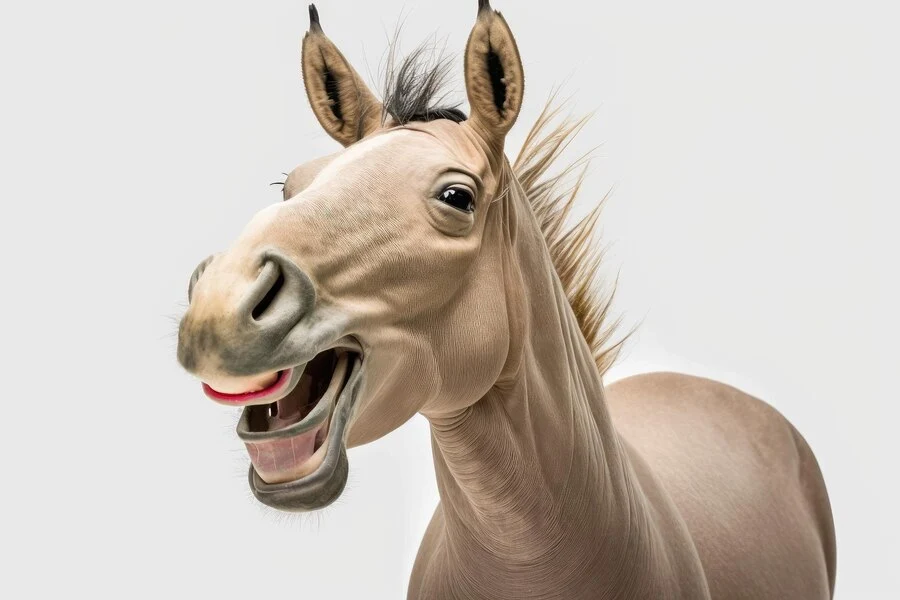
How to Read a Horse Racing Form Guide
Everything you need to know about using form guides for horse racing
Introduction
Horse racing form guides are confusing for beginners.
The first time you try to use one, it is daunting. It seems like an indecipherable mess of numbers and letters. Impossible to understand.
It’s hard to imagine you’ll ever be able to scan a form guide quickly and take in every piece of important information in seconds.
But, just like millions of other gamblers, it won’t be long until you’re doing just that.
Modern form guides have evolved over decades into a very helpful and usable tool that allows a punter to quickly take stock of any horse race.
This article is designed to introduce you to the horse racing form guide and help you add this vital tool to your betting arsenal.
Getting started with the form guide
The horse racing form guide is pretty much a punters best friend.
What looks like a complex document is actually very clever, functional and usable method of giving you key information about a horse race.
Here’s what this article aims to do:
- Show you what the form guide looks like.
- Tell you what all the different parts of the form guide mean.
- Explain how to use the information in the form guide to find more winners.
Let’s take a look at a typical form guide and begin breaking down all the different sections.
This will help you learn how to use the guide to build a picture of what a race is likely to look like, how it will pan out, and ultimately which horses are most likely to win.
Take a look at a typical form guide
Here is a form guide taken from the Racing Post, the leading industry newspaper and horse racing resource in the UK and Ireland.

What do all these parts of the form guide mean?
As we said earlier, we know this slew of information can be overwhelming.
But you’ll be amazed how intuitive and helpful the form guide will be for you, once you understand the anatomy of the document.
Let’s break down the form guide and explain each individual section for you.
Race Time
This one is pretty self-explanatory, but also very important. With over 50 horse races taking place on some days, even the most experienced gamblers often realise they are looking at the wrong race, and sometimes even one that has already been run!
TV Channel
Most horse races in the UK and Ireland are televised on one of the two dedicated horse racing TV channels – Racing TV or Sky Sports Racing. Sometimes races are also shown on terrestrial TV. In the UK this was traditionally Channel 4, but in recent years the broadcasting rights have been taken by ITV. This little corner of the form guide will always tell you where you can watch the race live.
Race Class
The race class is which category or band of horse racing the race on the form guide falls within. The horse racing authorities used to use letters to classify their races, but in recent years they’ve switched to using numbers. The range of race classes runs from 1-7, with Class 1 being the highest tier of horse racing, and Class 7 the lowest.
Distance
Horse racing in the UK and Ireland covers a wider range of distances than are used in almost every other leading horse racing country. The distances used also vary a good deal in the two professional racing codes – Flat and National Hunt or jumps racing.
The shortest races on the Flat are around five furlongs in distance (1000m/1100yd) with the longest in the British Isles around two miles and six furlongs (4400m/4840yd).
National Hunt races are longer on average, with the shortest National Hunt Flat races usually around one mile and five furlongs (2600m/2860yd). The longest races under this code are steeplechase or ‘chase’ races, including the Grand National, which are staged over around four and a half miles (7200m/7920yd).
Race Conditions
This section covers a range of information, some parts of which are more important than others. This includes Total Race Value – the prize money the horses are competing for. It also includes things like rating bands, minimum and maximum weight limits for jockeys, horse penalties and a prize money breakdown.
From a form analysis perspective, the most important piece of information here is probably the ratings band, if any. This is a further refinement of the Race Class system, particularly useful when assessing handicaps when you want to ascertain the exact standard of the race.
The race in the form guide example is a Class 5 hurdle race, but this can be further described as a 0-95 race, meaning that no horse can run that is rated higher than 95 (note. many handicap races now allow a 2lb margin above this limit, so you might see a 97 rated horse carrying top weight in a 0-95).
Class 5 handicaps only actually cover the 0-95 band, so this might not be the best example for this specific point. But the other Classes cover a range of 19lbs each, quite a wide spread of ratings. Therefore it’s important to know what the specific permitted ratings for the race will be.
List Of Runners
This is the most obvious and important section of the form guide. It shows a list of the horses running in the race (runners) with individual information for each individual horse displayed in each ‘Horse Detail’ sub-section.
This part of the form guide requires it’s own detailed explanation, which we will soon get to below.
Future Weight Changes
This small section shows future changes to the handicap marks of runners that have not yet taken effect. It also shows, such as in this example, horses that are not running from their Official Rating or handicap mark, due to the race conditions.
In the example form guide, Charlotte Square is due to run from a 14lb lower rating in future races. That’s purely because this horse is rated 14lbs below the lowest permitted jockey’s weight in this race, so will have to race here off a weight 14lb higher than it’s Official Rating. The Long Handicap number in this section shows the weight the horse would carry if there were no restrictions. Running with more weight than you deserve, and being present in the long handicap, is known informally as ‘running from out of the weights’.
Betting Forecast
This is an early forecast of the possible betting market, usually put together quite quickly by the publisher of the form guide. This forecast is not binding and the real betting market for the race will usually be very different to the forecast. However, these forecasts do a good job at showing if there is likely to be any clear favourites at the head of the market, or if it’s likely to be a more open betting race.
The Horse Detail part of the form guide. What do all those numbers and letters mean?!

The Horse Detail sub is by far the most important part of the form guide, and deserved it’s own breakdown because of the extensive key information it includes.
In a nutshell, the rest of the form guide shows you all the general information about the race.
The Horse Detail section shows only the information individual to each separate horse.
You’ll see the example Horse Detail image labelled in the same was as the Form Guide image earlier in this article.
So in just the same way, let’s list out and break down all the individual elements and what this information means, and can be used for.
Jockey Colours
This shows you what coloured silks the jockey on this horse will be wearing. These colours are actually the registered colours of the horse’s owner.
Some of racing’s most successful owners have very recognisable silks. For example, the dark blue silks and cap of Mrs John Magnier, the wife of Coolmore owner John Magnier, are perhaps the most successful racing silks in Flat racing globally over the past three decades.
In National Hunt racing, by far the most famous and recognisable silks are the emerald green with gold hoops and white cap of J.P. McManus, the legendary Irish gambler and record-holding champion owner.
Jockeys tend to wear different coloured silks in each race, unless they happen to be running for the same owner in consecutive races.
Form Figures
Super important information. The form figures show how the horse has been running in it’s most recent races, with the most recent race always on the right and then each number to the left in date order of when the horse ran.
The simplest way to understand these numbers for most runners is as follows.
Numbers 1-9 show where the horse finished in the first 9 of the race.
The number 0 means the horse finished 10th or worse.
Horse Name
Self explanatory, but important if you’re writing it on a betting slip. Horses are named in their country of registration and only one horse may use a name at a given time.
However, you will sometimes see conflicts where two horses from different countries share the same name and are active at the same time. This often happens with horses that move to the British Isles from France, where owners often use English words to name horses.
Since most countries don’t allow horses to change names, should a French horse with name that is already taken in the UK, be sold to race in the UK, you’ll have two horses of the same name racing concurrently in the same country.
Days Since Last Run
A small and subtle number, but one which can be very important in the context of a race and the chance of the horse in question.
If the horse has run in the past week, it could be tired and under perform.
If the horse has been off the track for a long time, often several hundred days following an injury, then it might be understandably rusty.
These factors aren’t always easy to predict, but they are a factor to consider. The stats say the best time to back a horse is if this number lies between 10 and 40 days.
However, the advantage of choosing horses based solely on this number is small and there are usually more significant factors present within the form.
Pedigree: Sire-Dam

This is where the sire (father) and dam (mother) of the horse are named. Although this information presents little value to a beginner, most experienced punters will have a good handle on facts relating to well-known sires (otherwise known as stallions).
Commonalities seen in the offspring of a stallion can have a bearing on the likely chances of one of it’s offspring winning. Furthermore, the stallions own racing preferences are very relevant to the likely preferences of his progeny.
This information is particularly useful when trying to predict the performance of young and unraced horses, and no racecourse form is available.
The bloodline of a horse can have a huge bearing on it’s preferred racing distance and ground conditions. Some stallions are also known for having offspring that mature early, whereas others progeny are known to develop more slowly.
Some very advanced gamblers will even know details about the dam (mother) of the horse, otherwise called the mare or broodmare.
The dam has just as much genetic influence on the offspring as the sire. Information about her own racing style, if any, along with familial traits in her wider family and previously raced progeny,
Horse Age
Horses start racing at the age of 2 on the Flat and you see few horses racing past the age of 10. Jumps horses typically mature more slowly, starting at the age of 3 and most careers ending by the age of 12.
Weight Carried
This shows how much weight the horse will carry. In professional Flat races in the UK, this weight will sit somewhere between the minimum limit of 8st 2lbs and the maximum weight limit of 10st 2lbs.
In National Hunt racing, the minimum weight limit is 10st 2lbs and the maximum weight limit is 12st.
These limits are typically higher for amateur races. Also, it is possible for a horse to be required to carry more than the maximum weight limit, they are required to carry a penalty for a recent win.
The total weight is made up of the jockey’s body weight, the saddle, plus any added weight necessary to ensure the horse carries the correct weight based on the race conditions. Extra weight is added by inserting lead plates into a weight cloth that sits underneath the saddle. Jockeys are required to weigh in after the race, along with the saddle and weight cloth, to ensure the correct weight was carried. Any failure to complete an acceptable weigh-in usually results in disqualification.
Racecard Number
The racecard number in the UK is the order in which the runners appear on the racecard. In a handicap, these numbers are determined by the weights the horses will carry. Number 1 on the racecard will carry top weight (although other horses may carry joint top weight).
In other races where weights are level, racecard number may be determined by the alphabetical order of the horse’s names. The racecard order will be determined for each race based on individual race conditions.
Trainer Name
This is where the trainer of this individual horse is named. A trainer can enter multiple horses in the same race. The number of licensed trainers in the UK varies annually but currently sits around 600.
Although gaining a license is difficult and all trainers have to pass a number of competency tests, there is a wide disparity in expertise and success across the training ranks.
The more you know about a trainers ability, past record and patterns of management with certain types of horse, the more betting advantages you can identify.
Owner Name
There are a few very high profile owners in the UK and Irish racing industry. Many of these have extensive breeding operations, and race their own homebred horses alongside any they might buy from other breeders or owners.
Although the owner should not influence betting too much, the biggest and richest owners often own the best horses. So in races where these owners have runners, the sheer presence of their racing colours on the horse might influence the betting market.
However, most horses are owned by smaller individuals or groups of owners and many races take place, particularly in lower class races, where the owners represented has no bearing on the betting market or result at all.
Jockey Name
Jockeys are the human athletes responsible for riding the horse during the race. As in any professional sport, the difference in ability between the best and worst riders is significant.
Although every professional jockey is a highly-skilled rider, the highest echelon of jockeys provide a clear and obvious advantage over less talented riders.
For a successful punter, it’s important to learn your jockeys and develop an opinion about their abilities. Sometimes, jockeys end up riding better horses for better trainers than their ability really justifies. For example, this could be due to family or other social ties with the trainer or owner responsible for choosing the jockey.
Conversely, there are a number of very good jockeys that have not been as fortunate, do not ride such high profile horses, but are significantly better jockeys than those ‘above’ them in the pecking order.
RPR Rating
RPR stands for ‘Racing Post Rating’. Although this number is only present on racecards published by the Racing Post, as the leading industry resource we felt it was important to cover this number in this article.
In fact, in the vast majority of licensed betting shops across the UK, you will see form guides and other information from the Racing Post newspaper stuck to the walls. This is to help people to make their betting decisions.
RPR is a number that is created on a race-by-race basis by professional form analysts working at the Racing Post. The highest RPR in a race is the horse with the best expected performance. You will see the highest RPR number in a circle with a black background with white text, the opposite colouring of all the lower RPR labels in the race.
The purpose of the RPR number is to make a prediction about the likely performance of each horse, based on today’s conditions and past form.
Each 1 point increment in the RPR represents 1lb of predicted performance, in the same way as the Official Rating system works.
An RPR for a horse will only be present if that horse has raced under rules in a qualifying race before. So an unraced horse that doesn’t meet these requirements will not have an RPR attached.
The analysts working at the Racing Post are experienced professionals and the horse with the highest RPR will often win the race. Although the RPR selections don’t make a profit over time, some gamblers will often follow these ratings or use them to help them pick a horse in a race where they can’t make their minds up.
The Racing Post Ratings for a whole meeting are also available in the paper.
Learn more about Racing Post Ratings in this very helpful article from the official Racing Post website.
Understanding Horse Racing Form Guide Abbreviations
In UK horse racing, form guides are packed with abbreviations that can be confusing for beginners.
This list breaks down the most common abbreviations and terms, making it easier to understand a horse’s racing history and performance when checking a form guid.
- Form Numbers: Numbers 0-9 indicate the horse’s position in previous races (0 means the horse finished outside the top 9).
- F: Fell during the race.
- P or PU: Pulled up by the jockey and didn’t complete the race.
- U or UR: Unseated rider.
- BD: Brought down by another horse.
- R: Refused to race or jump a fence/hurdle.
- D: Disqualified after the race.
- /: Indicates a break from racing (e.g., a season).
- -: Separates racing seasons (e.g., 4/3-2/1 means 4th and 3rd in the last season, 2nd and 1st this season).
- C: Course winner (won a race at the racecourse before).
- D: Distance winner (won over the same distance).
- CD: Course and Distance winner.
- B: Brought down by another horse during the race.
- S: Slipped up.
- V: Void race.
- BF: Beaten favourite last time out.
- OR: Official Rating – a numerical assessment of the horse’s ability by the handicapper.
- RPR: Racing Post Rating – an independent assessment of the horse’s performance.
- TS: Top Speed rating – a figure representing the fastest speed a horse has achieved in a race.
Understanding these abbreviations is crucial for using form guides properly and making better betting decisions.
While form guides are invaluable, they’re just one important tool that forms part of a successful betting process and strategy.



